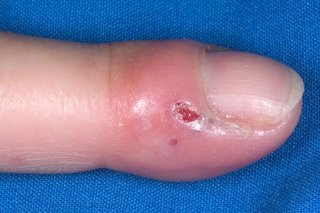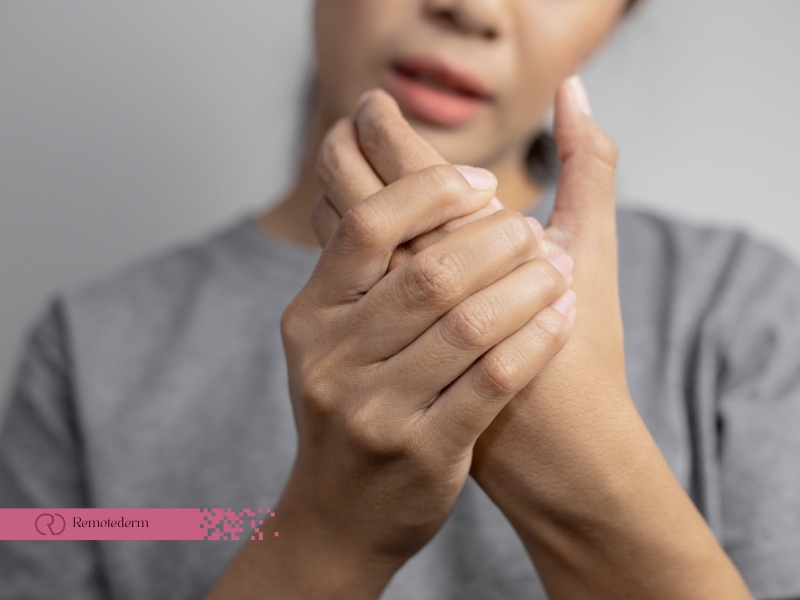Herpetic whitlow, a herpes simplex virus infection, is blamed for the development of painful blisters and in some cases fever. Early diagnosis is significant; watch for the sensory symptoms of burning or prickling and the presence of unique blisters as they indicate the condition. The faster the signs are noticed the more successful the treatment becomes. This text is flooded with data on herpetic whitlow that provides creative tips and breakthroughs. Whether you are in Canada or any other place, find out how you would protect yourself and others from a very contagious disease.
What is Herpetic Whitlow?
Herpetic whitlow is a viral infection that leads to blisters on the fingers as well as skin around that can be quite painful. Such warts across the surface area are mainly the result of skin-to-skin contact with the sore of an infected person. The rashes are called sometimes the same as the blisters.
Symptoms of Herpetic Whitlow
Herpes whitlows can appear on any of your fingers. Symptoms of herpetic whitlow can appear one to two weeks after virus exposure. You may develop one or more blisters. Although blisters are a common symptom of this condition, your fingers may become red or swollen first. The healing time of blisters can reach three weeks. Eventually, the blister or group of blisters ruptures, resulting in a shallow ulcer with a crusty scab. You may feel a burning or tingling pain that is more intense than you would expect from blisters. Herpetic whitlow can cause fever and swollen lymph nodes.
The signs and symptoms of herpetic whitlow are:
- Blisters are fluid-filled bumps on the skin near your fingernail.
- The skin around your nail changes color, usually becoming darker than your normal skin tone or turning red to purple.
- Swollen finger.

Although it’s not common, it is possible to have repeat outbreaks after the first one. Recurrent herpes outbreaks are usually less severe and heal faster because the body has developed antibodies to combat the virus.
Causes and Risk Factors
Herpes simplex virus (HSV) is the main culprit behind this infection, which causes highly contagious infections such as genital herpes, cold sores, and herpetic whitlow. There are two distinct types of HSV.
- Type 1 usually affects Lips, cheeks, and mouth regions
- Type 2 frequently affects the genitalia
Diagnosing Herpetic Whitlow
A sore or blister on your finger isn’t usually something to worry about. Many sores result from friction, insect bites, or minor injuries; they often heal on their own. However, if you notice a painful pus-filled pocket, known as an abscess, on your finger and can’t figure out the cause, it’s a good idea to consult your doctor. During the early stage herpetic whitlow, on suspicion of a virus, doctors may order a skin swab or blood test to give the final word on herpetic whitlow. Doctors are most likely able to diagnose the viral diseases by the sores of your lesions alone. Your clinician will tell you whether you have herpetic whitlow, based on the way the signs and symptoms show up only on your finger. The disease on your skin has a manifest look. The provider will give a PCR test or perform a culture test to make sure of the diagnosis.

Herpetic Whitlow Treatment Options
Herpetic whitlows don’t need any treatment. This kind of ailment usually heals on its own in just a few weeks and you can do without medication; but, the prescription antiviral can help to stop an outbreak sooner when you do it.
Antivirals also help reduce the likelihood of spreading the virus to other people. Your doctor can write an antibiotic prescription should a blister burst and an infection arise.
Herpetic whitlow can be handled at home by:
- Using a pain reliever, such ibuprofen or acetaminophen, to help lower fever and discomfort
- Several times a day applying a cold compress helps lower swelling
- Daily cleaning of the impacted area and covering it with gauze

Preventing Herpetic Whitlow
To avoid herpetic whitlow, keep away from people with active herpes infections. Wash your hands thoroughly; don’t touch open sores or blisters. Protective gloves can help when handling potentially infectious materials.
If you think you have herpetic whitlow, seek medical attention promptly. Get the right treatment to avoid spreading the infection; consult an online dermatology in Canada for quick access. Don’t share personal items like towels or utensils. This helps prevent the virus transmission.
Living with Herpetic Whitlow
Having Herpetic Whitlow can be very unpleasant. Those pesky blisters and sores on your fingers will make the simplest tasks incredibly difficult it seems. You need to seek the help of a healthcare professional because the control of the symptoms and the prevention of diseases are both important.
Without appropriate treatment, Herpetic Whitlow can potentially lead to nerve damage and even scarring. On some rare occasions, even the most serious infections may easily spread to other parts of the body, thereby causing other health problems. Get your healthcare provider on board to write the treatment plan; such a partnership can make the symptoms not so intense and minimize the impact of Herpetic Whitlow on your daily routine.
Final Thoughts
Herpetic whitlow, which is quite often confusing, is a viral infection affecting the skin that is worth noticing. The early symptoms like tingling and blisters of some kind of itchy virus are crucial to the management of the disease. Fast diagnosis and treatment are the most important things because they relieve pain and prevent complications. Always remember that: hygiene is your first line of defense. Avoid contact with infected sores. Knowledge is power. Awareness is the best defense.
FAQs
1. What is the difference between herpes herpetic whitlow and paronychia?
Herpetic whitlow is caused by the herpes simplex virus; paronychia is caused by the bacterial or fungal infections of the nail fold. Both diseases present pain and swelling, yet treatment modalities are diverse.
2. Can a patient with herpes simplex be completely healed after the required treatment?
Herpetic whitlow can recur, as well. The herpes simplex virus is latent in the body; stress or a weakened immune system can provoke outbreaks.
3. How long does it take to heal from herpetic whitlow?
The recovery time of herpetic whitlow is normally 2-4 weeks. The sores and blistering usually subside during this duration. If they are rapid-acting treatments, they can help in the healing process.
4. Can herpetic whitlow be transmitted to others?
Yes, herpetic whitlow is catching, especially while it is in the blistering phase. One should avoid direct contact with the affected area, including personal hygiene, to spread the virus.
